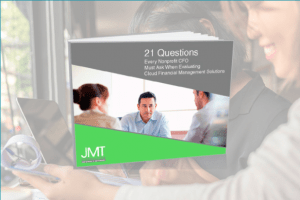Is Winter Storm Stella going to be your deciding factor for finally moving to the cloud? With this megastorm threatening much of the Northeast, your on-premise systems are in danger of being compromised. From having redundant data to dispersed geography and backup disaster recovery (BDR) processes, cloud computing protects organizations of all sizes from a vulnerable data center.
At JMT Consulting, we encourage our clients to look at all aspects of cloud computing. True cloud computing includes these principles:
Multitenancy
According to Gartner, “Multitenancy is a reference to the mode of operation of software where multiple independent instances of one or multiple applications operate in a shared environment.” Multitenancy provides the means for multiple tenants to share common access to software and infrastructure – where each tenant’s data is completely isolated and invisible to the other tenants.
Redundancy and security
True cloud computing has multiple, redundant data centers. One of JMT’s software partners, Intacct, hosts their fortune 100-class data centers in San Jose (operated by Savvis) and Sacramento (operated by Herakles). These world-class data centers offer redundant uninterruptable power supplies, parallel redundant generators, and redundant network components. When considering cloud computing, JMT recommends that the operational characteristics of privacy, availability, integrity and security are built into the system – not just an afterthought.
Scalability
Do you have peaks and valleys in your financial processes? Perhaps you need more resources during year-end closings than during end-of-month closings? If you answered yes, cloud computing can be your secret weapon because of the ability to share one code base across all customers, use resource pooling and elasticity to manage large numbers of transactions. The system scales to your needs without you having to worry about adding servers or installing additional software.
Future-proof
Cloud computing offers a bonus benefit of future-proofing your financial solutions. As new regulations are rolled out – whether it is changes in Uniform Grant Guidance, new Revenue Recognition Rules or the release of the FASB ASU 2016-14 – cloud computing enables pushing out new functionality all at once to the entire user base. All with no downtime.
The winds are changing. If you want to learn more about how a modern, cloud financial management system can help your nonprofit stay on track, contact JMT today.
 Read our eBook; 21 questions every nonprofit CFO should ask when evaluating Cloud Financial Management solutions.
Read our eBook; 21 questions every nonprofit CFO should ask when evaluating Cloud Financial Management solutions.
